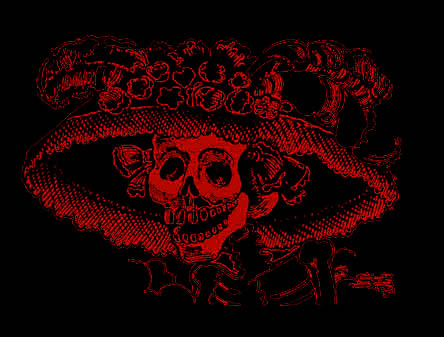
©1944 The Art Institute of Chicago
Mexico Lindo Home
|
José Guadalupe Posada~1851-1913 |
Josť Guadalupe Posada was born in the state of Aguascalientes, Mexico. In his early life he worked as a teacher of lithography and in 1887, he moved to Mexico City where he became a newspaper illustrator. His graphic work is well recognized and he often dealt with political, social and moral themes. Posada's "calaveras" (skeletons) represented here are images often associated with the the Day of the Dead, but their original intent was more satirical. "La Catrina", or the Female Dandy, was originally intended to poke fun at the upper class, during the autocratic rule of Porfirio Diaz.
Posada was a product of all that was best in the Mexicans of his time. He interpreted the history of his period with genius and intervened in Mexican destiny in a direct way. The powerful vigor of his artistic trend corresponds to his simplicity and genuine humility. His characteristics were a passion for work and study, loyalty to himself and his people, combined with the spontaneous poetry of a living tradition. He was a genius; no matter to what source he turned, he was able to develop a personal style which maintained itself through a work of incredible volume and high quality. Posada's art knew no decadence. He felt the life of Mexico in his time and was able to express the aesthetic feeling of his nationality with the same depth and quality as Mexicans of other ages. Posada revealed himself to be of the same nature as the Indian sculptor, author of the Aztec sculpture Coatlicue or The Goddess of Death, and other anonymous artists who, during three centuries of Colonial domination, carved sculptures in hundreds of churches and were able to develop a personal style. Posada's time was a most tumultuous one, in which a struggle involving the noblest aspirations took place. His life and works have become the foundation of Mexican printmaking and have vitally contributed to the formation of contemporary Mexican art.

|
| Excerpted from the article: "Jose Guadalupe Posada: The Man, His Art, His Times" by Fernando Gamboa, which originally appeared in "Posada: Printmaker to the Mexican People". The book accompanied an exhibit of Posada's work which appeared at the Art Institute of Chicago in 1944 and was lent to them by The Direccion General De Educacion Estetica, Mexico. ©1944 The Art Institute of Chicago |
|
back
Mexico Lindo Home |